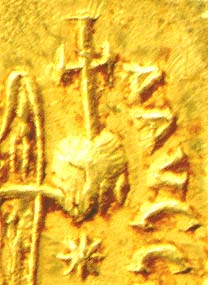 Contents -
Previous Article -
Next Article
Contents -
Previous Article -
Next Article
The Roman ruler who displayed the globis cruciger wished to convey the message that he or she was the supreme power and authority in the world and that this power was a divine institution or right instituted by God himself. Some rulers took this to mean that they could do anything they pleased with impunity because they were chosen by Christ to be His divinely inspired ruler. Needless to say, every ruler that used this symbol fell far short of what it was supposed to represent! Some modern people may be surprised to see the world represented as a sphere by the Romans. Many of us were told that people believed that the world was flat until Columbus showed us that it was round. The truth is that the Romans not only knew that it was spherical (the evidence is right there on the globis cruciger and rudder - and - globe coin reverses) but they had a reasonable approximation of the Earth's circumference. The Greek philosopher and mathematician Aristotle demonstrated that the Earth was a sphere before 300 B. C. and Eratosthenes calculated its circumference a hundred years later but his estimate was about 15% too low. Columbus himself is believed to have used Eratosthenes’ figures and this is probably what led him to believe he had reached Asia instead of a new continent. Only the uneducated and superstitious people believed that the Earth was flat and that anyone who sailed too far out into the Western ocean would fall off the edge. It is interesting what looking at an ancient coin can tell us. One of the author’s favorite tricks is to show a Byzantine gold solidus with globis cruciger reverse to a group of fourth or fifth graders studying the Age of Exploration or early California.
Go to next article: Labarum
Go back to previous article: Curule Chair
Return to Reverse Types Table of Contents